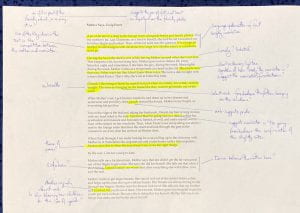
Please note the image above, which is the opening (exposition) to a narrative.
An effective exposition needs to:
- Establish setting
- Introduce the reader to the main character(s)- the protagonist
- Establish mood, tone
- Get the reader asking questions which draw them into the narrative
- Suggest potential conflict
SO… let’s look at the model above and what it tries to do:
- The opening sentence uses the verb ‘struggled’ to describe the sun. This could be considered personification but it suggests that the sun is having some degree of difficulty in rising. Is it winter? Does the narrative take place where it’s usually cold?
- The ‘craggy horizon’ suggests that the narrative is taking place in a mountain range or near a cliff. The adjective ‘craggy’ is doing a lot work here.
- The boys rise ‘gingerly’ to their feet. The adverb ‘gingerly’ evokes a sense that the boys are tired/exhausted or that they’re struggling. The reader is invited to ask why this might be the case. The adverb also echoes the struggling sun in the first sentence.
- The kestrel (a bird of prey and threatening in itself) is ‘perched malevolently’. The combination of verb and adverb is vaguely threatening.
- The ‘makeshift camp’ adds more context to where the boys are but we’re invited to question why they’re there. Why is it ‘makeshift’? It suggests they’ve not been there long, won’t stay long and are on their way to somewhere else? Why? Where? How?
In other words, there’s a lot going on in those few sentences, which set the tone for the narrative to sustain. Hopefully the reader would want to know more about the boys, their fate, the role of the ominous kestrel… We’re a couple of sentences in and we’re already into the world of the text.
When you write your narratives, aim to engage your reader as quickly as you can. Your eventual grade will depend on the quality of your exposition.

